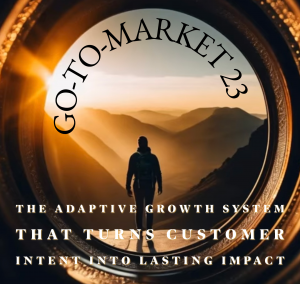Eric Malley Launches GTM 23: The Adaptive Growth System™
Human + AI: Inside Eric Malley’s GTM 23 System for Next-Gen Personalization
New Framework Empowers Brands to Achieve Ethical, Empathetic, and Effective Go-to-Market Strategies
Eric Malley, Editor-in-Chief of EricMalley.com and author of “Go-to-Market Playbook: 23 Proven Strategies to Achieve Super Bowl-like Success in Market Penetration and Revenue Growth in 2025,” announces the official release of GTM 23: The Adaptive Growth System™ a breakthrough approach that fuses artificial intelligence with multidimensional human insight for next-generation go-to-market (GTM) personalization.
Why Human + AI Is the Next Frontier in Go-to-Market Personalization
In a marketplace overflowing with “personalized” offers and algorithmic outreach, brands face a pivotal question: Can artificial intelligence alone create true customer connection? The answer, increasingly, is no. Data-driven automation is powerful, but the future of GTM success lies in blending machine intelligence with multidimensional human insight.
“As the creator of GTM 23: The Adaptive Growth System and Spherical Philosophy™, I’ve seen how the most resilient brands use AI to inform but never replace the human element,” said Eric Malley. “The future belongs to organizations that combine ethical technology with empathy and adaptability.”
The Limits of Data-Driven Personalization
For years, marketers have relied on AI-powered segmentation, predictive analytics, and automated outreach to deliver the right message to the right person at the right time. But as inboxes fill with “personalized” content, customers are growing wary of interactions that feel robotic or intrusive. Over-automation can erode trust, turning relationships into transactions and missing the nuances of human behavior, emotion, and context.
Consider the all-too-common scenario: a customer browses a product once and is then bombarded with retargeting ads for weeks. The brand’s AI thinks it’s being helpful, but the customer feels stalked. Or a chatbot offers “personalized” assistance but fails to understand the customer’s real frustration, leaving them more alienated than before.
The lesson is clear: AI can optimize, but it can’t empathize. Data can predict, but it can’t understand. GTM leaders must harness AI’s power without losing the human touch.
Spherical Philosophy™: Restoring the Human Element
Spherical Philosophy™ is a multidimensional framework developed by Eric Malley to help organizations thrive in complexity and change. It recognizes that real connection happens when brands see customers as whole people not just data points. This approach emphasizes empathy, ethics, and adaptability, asking GTM teams to step back and ask: Are we truly serving the customer’s needs? Are we respecting their privacy and preferences? Are we building relationships, or just driving transactions?
When applied to GTM personalization, Spherical Philosophy™ guides the integration of AI and human insight. Technology should enhance not replace the human capacity for understanding, compassion, and creativity. This philosophy cultivates multidimensional awareness, helping leaders see connections, anticipate consequences, and approach challenges from multiple perspectives.
GTM 23 in Action: Blending Human Insight with AI
GTM 23: The Adaptive Growth System is built on the belief that the best GTM strategies are dynamic and responsive. In this model, AI is a tool for insight, not just automation. It’s a way to gather signals, identify patterns, and inform decisions but it’s the human element that turns those insights into action.
Using AI for Insight, Not Just Automation:
Rather than automating every touchpoint, use AI to surface opportunities for genuine engagement. For example, AI can identify customers at risk of churn, but it’s a human who reaches out with a personalized message addressing their unique concerns.
Creating “Intent Loops” That Adapt to Real Customer Journeys:
Traditional funnels are linear; intent loops are dynamic. By mapping customer journeys as loops where feedback, context, and emotion are continuously integrated, brands can adapt in real time. AI helps track signals, but humans interpret and respond with empathy.
Building Feedback Mechanisms That Include Qualitative Input:
AI excels at quantitative analysis, but qualitative feedback customer stories, support tickets, social media sentiment adds depth and meaning. GTM 23 encourages teams to blend both, ensuring personalization is informed by real voices, not just numbers.
Case Study: Empathy-Driven Messaging in Action
A SaaS company using GTM 23 noticed that while AI-powered email sequences drove high open rates, actual conversions were stagnating. By reviewing qualitative feedback, they discovered customers felt overwhelmed and misunderstood. The team shifted to empathy-driven messaging shorter emails, more open-ended questions, and genuine offers to help. Conversions jumped by 28%, and customer satisfaction soared.
The Playbook: Actionable Steps for Human + AI GTM
Audit Your Current Personalization: Where is the human missing? Review your customer journeys and identify points where automation is overused or empathy is lacking.
Map Customer Journeys Using Intent Loops: Move beyond static funnels. Use AI to track signals, but design journeys that allow for feedback, adaptation, and real-time response.
Integrate Ethical Guidelines and Empathy Checks: Establish clear guidelines for data use, privacy, and personalization. Train teams to ask: Would I appreciate this as a customer? Does this message respect the person behind the data?
Use Spherical Philosophy™ to Train Teams on Multidimensional Thinking: Encourage teams to consider every angle: What does the data say? What does the context suggest? What might we be missing? Foster a culture of curiosity and compassion.
Measure Success by Both Quantitative and Qualitative Outcomes: Track open rates, conversions, and revenue but also monitor customer satisfaction, NPS, and qualitative feedback. Success is measured in relationships, not just results.
Final Thought
The future of go-to-market isn’t about choosing between AI and human intuition it’s about harnessing both. Brands that master this blend will achieve deeper loyalty, higher conversion, and lasting market impact. GTM 23 and Spherical Philosophy™ provide a roadmap for this new era: one where technology empowers empathy, and data-driven decisions are always guided by multidimensional human insight.
As you evolve your GTM strategy, remember: the magic happens when you see your customers not just as data points, but as multidimensional people. Combine the best of AI and human intuition, and you’ll unlock personalization that’s not just effective but unforgettable.
About Eric Malley
Eric Malley is the visionary behind Spherical Philosophy™ and Editor-in-Chief of EricMalley.com. Recognized as a leading authority on adaptive go-to-market strategy and organizational transformation, Eric empowers leaders and teams to bridge technology with human insight, unlocking sustainable growth and lasting impact. As a published author and trusted advisor across industries, he helps organizations thrive in complexity with clarity, multidimensional thinking, and resilience.
For interviews, speaking engagements, or more information, visit EricMalley.com.
Eric Malley
Ericmalley.com
eric|ericmalley.com| |eric|ericmalley.com
Visit us on social media:
LinkedIn
Other
Legal Disclaimer:
EIN Presswire provides this news content "as is" without warranty of any kind. We do not accept any responsibility or liability for the accuracy, content, images, videos, licenses, completeness, legality, or reliability of the information contained in this article. If you have any complaints or copyright issues related to this article, kindly contact the author above.
Studycat expands accent‑rich voice training for young learners in children Spanish language Android app
Resource Design & Build, LLC Completes Renovation at 6477 Old Shadburn Ferry Road
Naples Soccer Academy Welcomes Peter Giannopoulos as Director of Security
Więcej ważnych informacji
 Jedynka Newserii
Jedynka Newserii

 Jedynka Newserii
Jedynka Newserii

Konsument

Polacy nie korzystają z hossy trwającej na warszawskiej giełdzie. Na wzrostach zarabiają głównie inwestorzy zagraniczni
Od października 2022 roku na rynkach akcji trwa hossa, nie omija ona także warszawskiej giełdy. Mimo to inwestorzy indywidualni odpowiadają zaledwie za kilkanaście procent inwestycji, a o wzrostach decyduje i na nich zarabia głównie kapitał z zagranicy. Widać to również po napływach i odpływach do i z funduszy inwestycyjnych. Zdaniem Tomasza Koraba, prezesa EQUES Investment TFI, do przekonania Polaków do inwestowania na rodzimej giełdzie potrzeba zysków z akcji, informacji o tych zyskach docierającej do konsumentów oraz czasu.
Polityka
Obowiązek zapełniania magazynów gazu w UE przed sezonem zimowym ma zapewnić bezpieczeństwo dostaw. Wpłynie też na stabilizację cen

Unia Europejska przedłuży przepisy z 2022 roku dotyczące magazynowania gazu. Będą one obowiązywać do końca 2027 roku. Zobowiązują one państwa członkowskie do osiągnięcia określonego poziomu zapełnienia magazynów gazu przed sezonem zimowym. Magazyny gazu pokrywają 30 proc. zapotrzebowania Unii Europejskiej na niego w miesiącach zimowych. Nowe unijne przepisy mają zapewnić stabilne i przystępne cenowo dostawy.
Infrastruktura
Gminy zwlekają z uchwaleniem planów ogólnych zagospodarowania przestrzennego. Może to spowodować przesunięcie terminu ich wejścia w życie

Reforma systemu planowania i zagospodarowania przestrzennego rozpoczęła się we wrześniu 2023 roku wraz z wejściem w życie większości przepisów nowelizacji ustawy z 27 marca 2003 roku. Uwzględniono w niej plany ogólne gminy (POG) – nowe dokumenty planistyczne, za których przygotowanie mają odpowiadać samorządy. Rada Ministrów w kwietniu br. uchwaliła jednak ustawę o zmianie ustawy z 7 lipca 2023 roku, a jej celem jest zmiana terminu obowiązywania studiów uwarunkowań i kierunków zagospodarowania przestrzennego gmin na 30 czerwca 2026 roku. Wskazana data może nie być ostateczna z uwagi na to, że żadna z gmin nie uchwaliła jeszcze POG.
Partner serwisu
Szkolenia

Akademia Newserii
Akademia Newserii to projekt, w ramach którego najlepsi polscy dziennikarze biznesowi, giełdowi oraz lifestylowi, a także szkoleniowcy z wieloletnim doświadczeniem dzielą się swoją wiedzą nt. pracy z mediami.










.gif)

 |
| |
| |
|